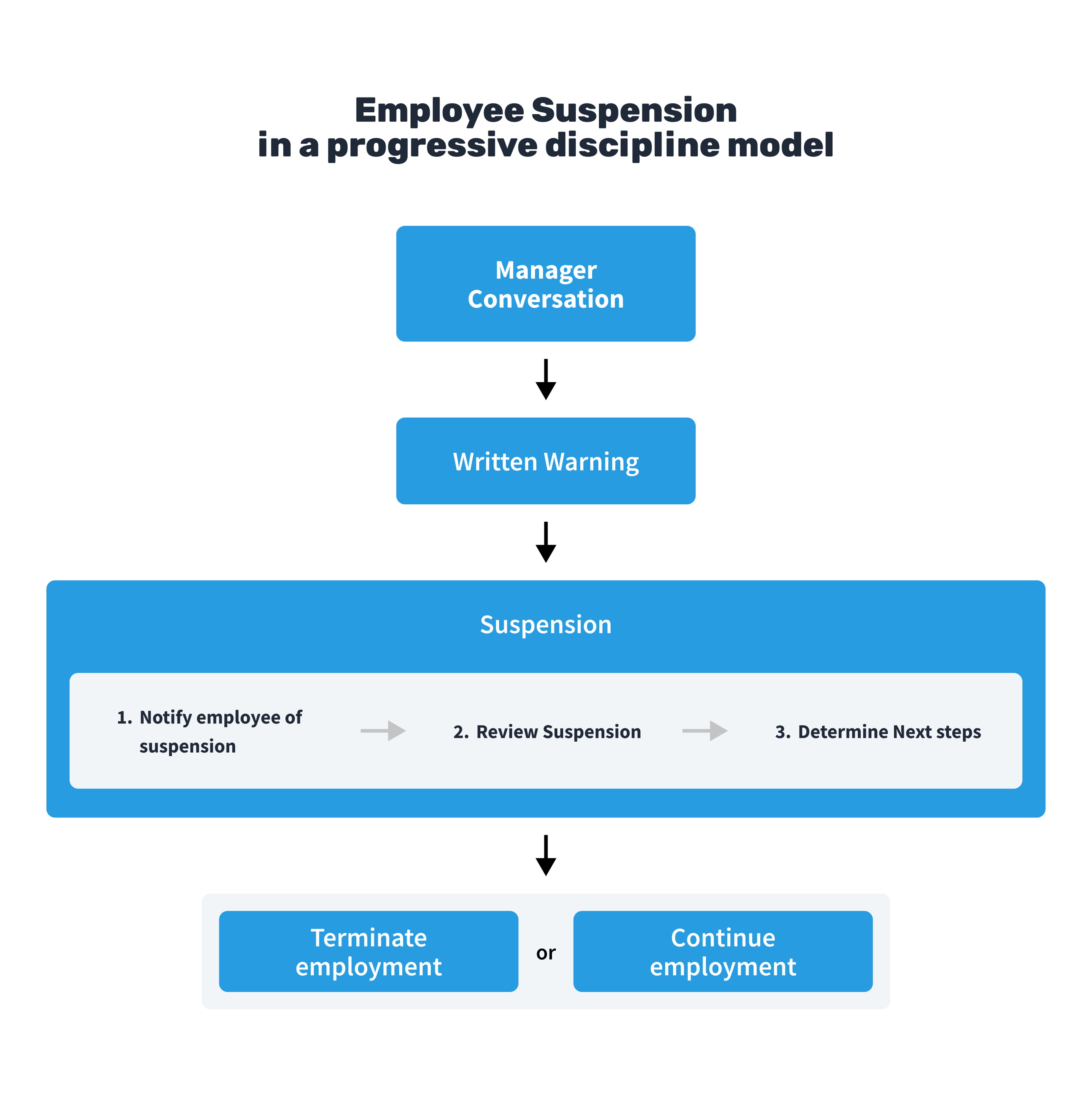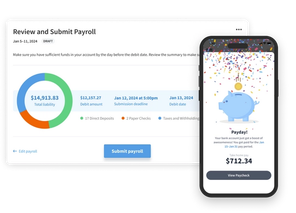
Eddy’s HR Mavericks Encyclopedia
The world's largest free encyclopedia of HR, with 700+ HR articles and podcasts.
Created by Eddy and our HR Mavericks community.
Employee Suspension
Sometimes employee suspension becomes necessary after serious accusations have been leveled against an employee. This gives company personnel time to investigate claims and make a thoughtful decision while removing a potential threat from the workplace. This article gives insight into when this becomes necessary, and how to implement it well.
What Is Employee Suspension?
Employee suspension is a step in the progressive discipline process that removes an employee from the workplace when performance issues, misconduct, or serious incidents necessitate a review and decision about retaining the employee. It also provides a “cooling off” period when tension is high. People management is incredibly difficult, especially when situations like this arise.

Reasons For Suspending an Employee
Employees may be suspended for several reasons. Companies should establish policies and inform employees about the progressive discipline process and the possible need to impose suspensions when warranted.
Reason 1: Misconduct and Poor Performance
When employees ignore workplace rules or fail to perform according to expectations, smart leaders will immediately engage the employees in coaching conversations. If the behavior doesn’t change, the discipline may escalate to one or more verbal warnings, followed by one or more written warnings. Continued failure to perform as expected may lead to a suspension. This step in the progressive discipline process usually gets the attention of employees who haven’t taken the previous steps seriously. It allows them time to decide if they want to remain employed and recommit to the expectations of the company. It also notifies them that future infractions may lead to termination of employment.

Document everything in Eddy
Create notes in Eddy to track important information from performance reviews, improvement plans, disciplinary issues, and more.
Document everything in Eddy
Create notes in Eddy to track important information from performance reviews, improvement plans, disciplinary issues, and more.

Reason 2: Serious Misconduct
If an employee commits a serious infraction, such as threatening other employees or causing harm to others through careless behavior, a company may need to remove the employee from the workplace immediately while investigating the incident(s) and making a final decision about the employee’s future with the company. A suspension allows a careful review process that would otherwise conflict with the urgency of a quick decision.
Reason 3: Conducting Internal Investigations
Sometimes a company may need to conduct an investigation as a routine measure when certain issues arise. It can be helpful to suspend employees who may be involved so the investigation won’t be hindered. This doesn’t presume guilt on the suspended employees but allows for a thorough review without interference.
How To Suspend an Employee
A suspension can be stressful for employees who realize their future with the company may be in jeopardy. Proper care by the employers can minimize the adverse effects on the employees involved and their co-workers.
Step 1: Notify the Employee
When the decision has been made to suspend an employee, the company should notify the employee of the reason(s) for and the duration of the suspension. Employees should be informed about payment status during the suspension and any guidelines to observe. Such guidelines may include staying away from company premises and removing access from company systems so they are unable to perform any work. Employees should be told when and where to report or call in at the end of the suspension period. These guidelines should be documented in writing and presented to the employee so there can be a mutual understanding of expectations.

Document everything in Eddy
Create notes in Eddy to track important information from performance reviews, improvement plans, disciplinary issues, and more.
Document everything in Eddy
Create notes in Eddy to track important information from performance reviews, improvement plans, disciplinary issues, and more.

Step 2: Be Timely and Consistent with Decisions
Investigation and discipline decisions should be made in a timely manner and with consistency. Fairness is essential in maintaining a strong workplace culture. Consistency ensures protection against any form of discrimination. If the investigation takes longer than originally expected, the suspension can be extended.
Step 3: Document the Decision
Once a final decision has been made, the company should document the reasons for the decision and notify the suspended employee.
How To End an Employee Suspension
At the end of the established suspension period, the employer (usually HR or the employee’s manager) should meet with the employee at the designated time and place to review the next steps. If an employee has decided to terminate their employment during the suspension period, they may not call in as requested or respond when the company reaches out. In such cases, if the outcome of the suspension would have been returning to their positions, employers may consider these employees as having voluntarily quit their employment. Employers should document the failure of these employees to follow up as instructed and proceed as they would with any other employee who leaves the company.
Scenario 1: Employee is Terminated
If the decision has been made to terminate the suspended employee, the employer should proceed with a formal termination. This may include delivering a final paycheck to the employee, providing the employee with termination paperwork or severance agreements, and explaining benefits and other information they need to know.
Scenario 2: Employee Stays Employed
If the decision has been made to allow the employee to remain with the company, the employer should discuss future expectations for the employee and consequences for failure to perform as expected. This conversation should be followed up with a written performance plan.
Scenario 3: Employee is Innocent
If the suspended employee was involved in an incident but found not culpable during the investigation, the employer should thank the employee for their cooperation during the suspension and inform them of any expectations moving forward. Since it wasn’t a performance-based suspension, no written performance plan is necessary. It is advisable to document the reasons for the suspension and the results of the investigation. Now that you know how successfully manage an employee suspension, schedule a demo of Eddy People today to see how we can make people management even easier!
Topics

Carol Eliason Nibley
Carol Eliason Nibley, SPHR, GPHR and Principal Consultant at PeopleServe, has more than 25 years of experience in human resources, most recently serving as Vice President of Human Resources for a technology company in Utah County. Carol has taught HR certificate courses at Mountainland Technical College and in other settings for more than 12 years.
Frequently asked questions
Other Related Terms
Eddy’s HR Mavericks Encyclopedia
Employee Suspension
Sometimes employee suspension becomes necessary after serious accusations have been leveled against an employee. This gives company personnel time to investigate claims and make a thoughtful decision while removing a potential threat from the workplace. This article gives insight into when this becomes necessary, and how to implement it well.
What Is Employee Suspension?
Employee suspension is a step in the progressive discipline process that removes an employee from the workplace when performance issues, misconduct, or serious incidents necessitate a review and decision about retaining the employee. It also provides a “cooling off” period when tension is high. People management is incredibly difficult, especially when situations like this arise.

Reasons For Suspending an Employee
Employees may be suspended for several reasons. Companies should establish policies and inform employees about the progressive discipline process and the possible need to impose suspensions when warranted.
Reason 1: Misconduct and Poor Performance
When employees ignore workplace rules or fail to perform according to expectations, smart leaders will immediately engage the employees in coaching conversations. If the behavior doesn’t change, the discipline may escalate to one or more verbal warnings, followed by one or more written warnings. Continued failure to perform as expected may lead to a suspension. This step in the progressive discipline process usually gets the attention of employees who haven’t taken the previous steps seriously. It allows them time to decide if they want to remain employed and recommit to the expectations of the company. It also notifies them that future infractions may lead to termination of employment.

Document everything in Eddy
Create notes in Eddy to track important information from performance reviews, improvement plans, disciplinary issues, and more.
Document everything in Eddy
Create notes in Eddy to track important information from performance reviews, improvement plans, disciplinary issues, and more.

Reason 2: Serious Misconduct
If an employee commits a serious infraction, such as threatening other employees or causing harm to others through careless behavior, a company may need to remove the employee from the workplace immediately while investigating the incident(s) and making a final decision about the employee’s future with the company. A suspension allows a careful review process that would otherwise conflict with the urgency of a quick decision.
Reason 3: Conducting Internal Investigations
Sometimes a company may need to conduct an investigation as a routine measure when certain issues arise. It can be helpful to suspend employees who may be involved so the investigation won’t be hindered. This doesn’t presume guilt on the suspended employees but allows for a thorough review without interference.
How To Suspend an Employee
A suspension can be stressful for employees who realize their future with the company may be in jeopardy. Proper care by the employers can minimize the adverse effects on the employees involved and their co-workers.
Step 1: Notify the Employee
When the decision has been made to suspend an employee, the company should notify the employee of the reason(s) for and the duration of the suspension. Employees should be informed about payment status during the suspension and any guidelines to observe. Such guidelines may include staying away from company premises and removing access from company systems so they are unable to perform any work. Employees should be told when and where to report or call in at the end of the suspension period. These guidelines should be documented in writing and presented to the employee so there can be a mutual understanding of expectations.

Document everything in Eddy
Create notes in Eddy to track important information from performance reviews, improvement plans, disciplinary issues, and more.
Document everything in Eddy
Create notes in Eddy to track important information from performance reviews, improvement plans, disciplinary issues, and more.

Step 2: Be Timely and Consistent with Decisions
Investigation and discipline decisions should be made in a timely manner and with consistency. Fairness is essential in maintaining a strong workplace culture. Consistency ensures protection against any form of discrimination. If the investigation takes longer than originally expected, the suspension can be extended.
Step 3: Document the Decision
Once a final decision has been made, the company should document the reasons for the decision and notify the suspended employee.
How To End an Employee Suspension
At the end of the established suspension period, the employer (usually HR or the employee’s manager) should meet with the employee at the designated time and place to review the next steps. If an employee has decided to terminate their employment during the suspension period, they may not call in as requested or respond when the company reaches out. In such cases, if the outcome of the suspension would have been returning to their positions, employers may consider these employees as having voluntarily quit their employment. Employers should document the failure of these employees to follow up as instructed and proceed as they would with any other employee who leaves the company.
Scenario 1: Employee is Terminated
If the decision has been made to terminate the suspended employee, the employer should proceed with a formal termination. This may include delivering a final paycheck to the employee, providing the employee with termination paperwork or severance agreements, and explaining benefits and other information they need to know.
Scenario 2: Employee Stays Employed
If the decision has been made to allow the employee to remain with the company, the employer should discuss future expectations for the employee and consequences for failure to perform as expected. This conversation should be followed up with a written performance plan.
Scenario 3: Employee is Innocent
If the suspended employee was involved in an incident but found not culpable during the investigation, the employer should thank the employee for their cooperation during the suspension and inform them of any expectations moving forward. Since it wasn’t a performance-based suspension, no written performance plan is necessary. It is advisable to document the reasons for the suspension and the results of the investigation. Now that you know how successfully manage an employee suspension, schedule a demo of Eddy People today to see how we can make people management even easier!
Topics

Carol Eliason Nibley
Carol Eliason Nibley, SPHR, GPHR and Principal Consultant at PeopleServe, has more than 25 years of experience in human resources, most recently serving as Vice President of Human Resources for a technology company in Utah County. Carol has taught HR certificate courses at Mountainland Technical College and in other settings for more than 12 years.
Frequently asked questions
Other Related Terms
Eddy's HR Newsletter
Sign up for our email newsletter for helpful HR advice and ideas.


